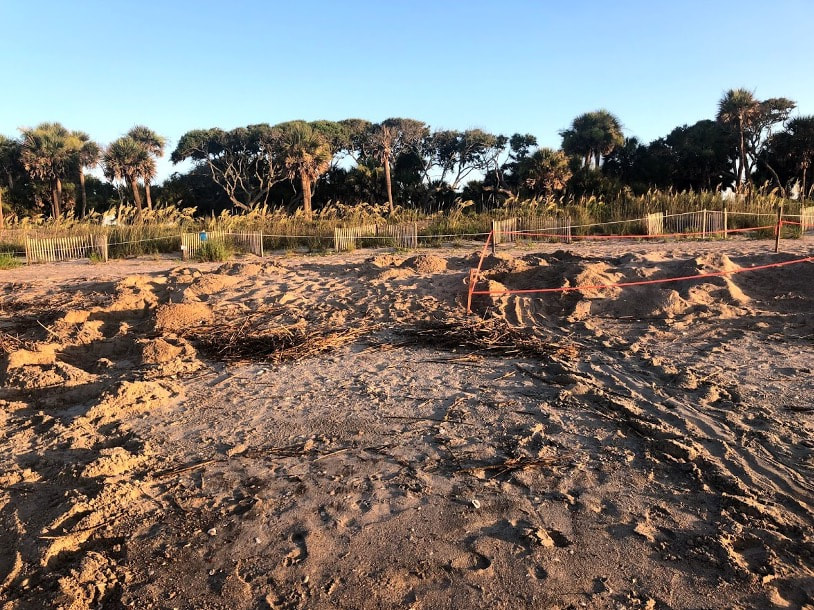|
Blog Post By: Aidan, Sea Turtle Intern For my final blog post, I wanted to highlight some of my favorite moments during nesting season. I really enjoyed my time at Edisto Beach interning with the state park and working with all the great volunteers. On our June 15th dawn patrol, we saw a nesting turtle still ashore to our surprise at 6:20 am. She finished up covering and disguising her nest before returning to sea. I was excited to see my first daylight loggerhead turtle. On a nice rainy morning, we had the second evidence of our “crazy turtle”. This time it was a pile of body pits over a vast area of sand. This spot would become known as possible nest 4 (PN4). We probed the area for possible eggs for almost an hour as the skies unleashed a downpour on us. The best part about that is we could still see our probe marks in the sand over a month later. Ironically, the same turtle came up the next day and dug eight more body pits in the same area without nesting. We had a special surprise on our July 17th night walk with two nesting sea turtles within minutes of entering the beach. After hearing that there was a nesting turtle near the pavilion to the right of the beach access, we walked out below the high tide line. Directly to the left, there was another turtle emerging out the ocean. While the commotion of some onlookers did not stop the turtle, she did false crawl after making her way up the beach. However, we were not too upset as we knew we would have another turtle to watch momentarily. On the July 21st night walk, we got to see two nests boil. The second boil had around 100 hatchlings making it a spectacular sight to see. There were so many it looked as if the ground was moving in front of us!
2 Comments
Blog Post By: Aidan, Sea Turtle Intern
Recently, we have been having a nesting loggerhead nicknamed “crazy turtle”. This turtle has been repetitively coming ashore and leaving behind numerous body pits. The mystery of this turtle was solved when our night walk saw that this turtle was incapable of properly digging an egg chamber. This led me to think about what causes these sorts of strange nesting behaviors in sea turtles. Oftentimes, nesting turtles tend to follow similar nesting behaviors when they come ashore to nest over the years. Some turtles show preferences for nesting higher up the beach in the dunes while others nest lower below the high tide line. Some individuals might be more selective as to where they nest and might false crawl more than other turtles. Last summer while interning in Costa Rica, I observed a green sea turtle intent on moving several hundred feet into the rainforest next to the beach. It would remain ashore for hours every night sometimes trying to body pit and dig egg chambers on the roots of trees. I also witnessed a feisty green sea turtle that would snap its jaws and throw its flippers at us when attempting to read tags. It abandoned the nest covering and disguising process at the slightest disturbance. Sea turtles have a small peanut-sized brain that is minuscule compared to the size of the mammalian brain. They lack the part of their brain that allows them to establish thought processes as we do. Due to this, sea turtles rely entirely on instinct as opposed to thinking and emotion. This explains why such behaviors are repetitive and do not normally improve over time. The behavior observed in our “crazy turtle” is likely caused by neurological conditions that affect how the turtle interprets its instincts. Behaviors in other turtles might be caused by genetics or physical injuries that affect the nesting process. These peculiar turtles are simply following what they think will lead to a successful nest. However, their instincts are not as they are meant to be, and these nesters will struggle to produce a viable clutch. While instinct is beneficial for turtles allowing them to survive and nest without any parental care, it does have its negatives. It will be interesting to see if our strange nesting loggerhead returns to our beach again in two to three years time. On our final night walk of the 2020 season, we were hopeful for some turtle activity! We were able to see a couple stragglers come out of nests that had emerged already, which was still very exciting. We watched over the hatchlings all the way to the water to ensure their safe crawl. We also witnessed 10 hatchlings from a nest closer to the inlet that had emerged just earlier that night. However, these hatchlings had been swarmed by fire ants. The fire ants are a a predator of our hatchlings and as you can imagine, it does not take that many bites from a fire ant to overwhelm the hatchling. Although it was not as joyful as our first couple hatchlings, we were thankful to be there to help them.
The following morning we found 2 nests emerged. There were no new nests found. Thanks again for all of the support for our sea turtle night walk programs this year. They were a lot different with the limited attendance, mask and distancing but we were so happy to be able to offer them again this season. Registration for 2021 Night Walks will begin in May, so keep that in mind for next year! |
Leah SchwartzentruberSea Turtle Biologist Archives
June 2024
|

 RSS Feed
RSS Feed